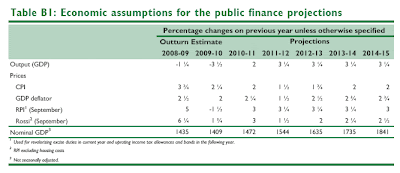The fiscal projections in yesterday's PBR - just like last April's budget - rest on economic growth assumptions that are extraordinarily optimistic.
Here is the relevant table from the PBR (click on image to enlarge):
Here is the relevant table from the PBR (click on image to enlarge):
As we can see, GDP growth is assumed to bounce back in very short order to reach 3.25% pa from 2011-12 onwards. Over the five year forecast period from 2010-11 it is supposed to average 3% pa.
But in a world of over-indebtedness, zombie banks, and tax increases, that is highly unlikely. Consider:
-
- The average of independent forecasts for more or less the same period (2010 to 2013) is just 2% pa - and that figure was calculated and published by the Treasury itself (see here page 18).
- Last time we had to tackle a fiscal crisis even remotely like the current one - in the 70s - GDP growth was pretty close to zero for the following five years: in fact between 1976 Q4, when the IMF arrived, and 1981 Q1, when Geoffrey Howe finally completed the necessary fiscal consolidation, UK growth averaged just 0.4% pa.
So what if we adjust the Treasury's growth numbers down to a more plausible level? What happens to the projected budget deficit?
As we've mentioned before, the Treasury's own rule of thumb says that one percent off GDP growth, increases the fiscal deficit by 0.7 percentage points of GDP. Which as things stand comes to around £10bn in cash terms.
But of course, that's cumulative. If GDP growth is 1% pa lower than HMT's forecast, by the end of 5 years, the fiscal deficit will be running £50bn higher than the Treasury forecasts.
As we've mentioned before, the Treasury's own rule of thumb says that one percent off GDP growth, increases the fiscal deficit by 0.7 percentage points of GDP. Which as things stand comes to around £10bn in cash terms.
But of course, that's cumulative. If GDP growth is 1% pa lower than HMT's forecast, by the end of 5 years, the fiscal deficit will be running £50bn higher than the Treasury forecasts.
Well, actually it will be more than that, because by the end of 5 years, with all that extra borrowing, government debt will be £150bn higher than the Treasury projects. Which means interest costs will be higher. And even if we assume the government can go on borrowing at around 4% - a very heroic assumption - that's another £6bn pa on the deficit.
In other words, if GDP growth from next year turns out to be 2% pa rather than the 3% pa assumed by HMT, the 2014-15 deficit will be £56bn higher. Which means that if we take the average of independent GDP forecasts, by 2014-15 borrowing will not be £82bn as the Treasury projects, but more like £140bn - a very small improvement on this year's £178bn.
And if we take our post-IMF growth experience from the 70s as a guide, then on PBR policies, borrowing in 2014-15 will be an horrendous £228bn (equals (3.0 minus 0.4) times £56bn plus £82bn).
And you know, it could be even worse than that. Because even given its optimistic GDP forecast, HMT is making the additional assumption that tax revenues from the hard-hit finance and property sectors recover strongly as a share of GDP (from 2.5% this year to 3.5% by 2014-15). But if the property market remains sluggish, and the banks start liquidating the bad debts they still hold, then tax revenues will be much less. That could easily add a further £15-20bn to annual borrowing.
And if we take our post-IMF growth experience from the 70s as a guide, then on PBR policies, borrowing in 2014-15 will be an horrendous £228bn (equals (3.0 minus 0.4) times £56bn plus £82bn).
And you know, it could be even worse than that. Because even given its optimistic GDP forecast, HMT is making the additional assumption that tax revenues from the hard-hit finance and property sectors recover strongly as a share of GDP (from 2.5% this year to 3.5% by 2014-15). But if the property market remains sluggish, and the banks start liquidating the bad debts they still hold, then tax revenues will be much less. That could easily add a further £15-20bn to annual borrowing.
Finally, the PBR projections assume unemployment stops rising in 2011. But back in the 70s, unemployment went on rising for nine whole years after the IMF visit - even after GDP had started to grow again. Which would put further upward pressure on borrowing.
All of which goes to underline the urgent need for strong fiscal action. Because yesterday's fiscal forecasts - alarming though they are - almost certainly understate the severity of the crisis.
